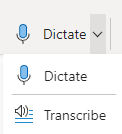Did you know your favourite Microsoft applications like Word, Outlook, PowerPoint, and OneNote have handy in-built features that let you get your ideas down on the page faster than typing, or while your hands and eyes are occupied with other things? Speech-to-text or text-to-speech programs can translate spoken language into digitised text and read written text aloud, making them a game-changer for studying.

Using speech-to-text can free up your train of thought so you can focus more easily on the task at hand. This allows you to not be sidetracked by grammar, sentence structure, spelling or paragraph structure when you’re writing your assignments – instead these can be dealt with in the editing process after you get your thoughts down on the virtual paper.
Speech-to-text can be used by students with motor skill limitations, physical disabilities, blindness/low vision, or other difficulties accessing a standard keyboard and mouse. By removing the physical barriers to writing as well as navigation of the computer, students with disabilities can benefit from these technologies and improve their writing and reading abilities.
How do I use it?
- The ‘Dictate’ button can transcribe the words as you speak and instantly get them down on paper.

- Go to Home > Dictate. First-time users will be prompted to enable microphone permissions.
- A mic icon will appear – wait for it to turn on to be sure it has started listening.
- Insert punctuation any time by saying them explicitly (e.g. “comma”).
- Use ‘Transcribe’ to upload pre-recorded audio or to transcribe as you speak, while saving the transcription as an audio file.

The ‘Immersive Reader’ button can read out the document or the selected text. This can be text from any application you paste in.

- Click ‘View’ and then select ‘Immersive Reader’.
- In Immersive Reader, select the Play button at the bottom.

There are also free web or mobile apps, such as Otter, that do speech-to-text and can generate an instant transcript from lectures, Zoom meetings, and interviews.
UTS students also have access to Read&Write, a literacy software for English Language Learners, as well as people with dyslexia or other learning difficulties. Features include:
- Text-to-speech: Reads words, passages, or whole documents aloud with easy-to-follow dual color highlighting.
- Text & Picture Dictionaries: Provide definitions and display images to help with word comprehension.
- Vocabulary List: Creates a list instantly into a new doc, including selected words, the dictionary definitions, images from Widgit Symbols, and an editable notes column.
- Check It: Reviews writing for incorrect grammar, spelling (phonetic), capitalization, punctuation, verb tense and more.
- Audio Maker: Converts selected text into an audio file, and automatically downloads.
- Talk&Type: Turns the spoken word into text
If you’re after more study tips, academic support, health and wellbeing help or social events and fun stuff, head to the Supporting online study portal.

